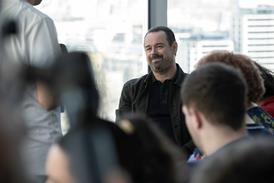I've been down at Wildscreen this week. It's the world's largest international wildlife and environmental film festival and features screenings, seminars, film competitions and parties.
I was there to witness the launch of Panasonic's P2 Varicam camcorders and to learn more about IT-based, or if you prefer file-based, or if that doesn't suit, tapeless production. Here are my highlights from the session.
The Panasonic event attracted a very impressive panel. On the stage were:
- Mark Linfield (Great Ape Productions/BBC)
- Marc Baleiza (BBC Bristol)
- Martin Dohrn (Ammonite)
- George Panayiotou (Films at 59)
- Alastair Fothergill (Great Ape Productions/BBC)
- Richard Mills (On Sight)
Chairman for the day Marc Irwin from Panasonic kicked things off by giving the assembled audience a low down on the new cameras - this being the first time that they've been available in this country.
He detailed that the P2 Varicam's come in two flavours. The AJ HPX 2700 - effectively a replacement for the tape based Varicams but with knobs on - and the 3700 which is proper grown-up Varicam. Both shoot DVCPro HD and AVC Intra (50 and 100) and offer 10-bit recording.
You can shoot 4:2:2 on the 2700 and 4:4:4 uncompressed (via an external dual link machine) on the 3700, which has a 1920 x 1080 chip. Irwin also made reference to some key words that he feels are associated with these Pana cameras: heritage, flexibility and choice.
Once the stats and figures were done with, the panel gave their thoughts on tapeless acquisition and on P2 Varicams. These were the ten things that I thought were most interesting.
Mark Linfield, who is currently in production on Frozen Planet for the BBC, is very positive about the fact that solid state cameras record the frames you want when using variable frame rates. This removes the need for frame rate conversion. This is a real advantage he says.
Martin Dohrn started working tapelessly years ago. Although not in the way you might expect. He is quite used to taking a tape deck into the field and digiziting there and then. For him, the advent of memory cards makes this a hell of a lot easier, not least because he no longer needs the huge, heavy deck.
Dohrn also thinks that being tapeless streamlines his workflow. He uses the recorder in the field to decide if he's got the right shots
The best thing about P2 Varicams, says Linfield, is the 10-bit recording which allows you to shoot lowcast images (those which have a high contrast?) and grade later. This way you can get pictures that ‘really fly.'
Alastair Fothergill particularly likes the fact that tapeless shoots are making filmmakers think creatively on location. He advises that storyboarding in the field is a good idea as is thinking hard about each shot, like on a film-based shoot.
Fothergill predicts that there will be no tape-based cameras in two to three years time.
Dohrn says that the 10 hours shooting time possible with five 32GB P2 cards in a Varicam is plenty long enough for most wildlife shoots. He also thinks that this approach will mean less time spent changing tapes and, as a result, less chance of missing a shot because of changing tapes.
According to Richard Mills (who, as an aside, is apparently a bit of a pub quiz genuis) the P2 Varicams benefit from full raster - which means the quality is not reduced throughout the production process - and the resolution being a third better.
The media is your asset, says Marc Baleiza. If you lose it you are screwed so back it up, protect it. Baleiza also suggests that the post process can start the instant the shots have been downloaded as you can log, delete and organise footage there and then.
According to one gentleman in the audience, tapeless workflows don't suit many one-man bands or small independents as the filmmaker doesn't have the time at the end of each day to download footage and add metadata.
There was also plenty of advice for those considering a tapeless shoot
Makes sure your crew and production team are computer literate.
Plan everything before you go, including file naming conventions.
Get the producer to watch the shoot and decide what he likes and doesn't like there and then.
Back up in the field, make the most of mode RAID - simultaneous download - so you get two versions of your media.
Employ a media manager and/or a camera assistant.
I found the session surprisingly interesting, which is good going as I don't know a great deal about wildlife filmmaking. Some of the intricacies of the genre are quite niche, but long days, power generators and damp tape stock are - or certainly were - all problems at one point. Now it is file names, on-location deletion and media management that are talking points.
Suffice to say, there is a real interest in tapeless technology within this community - and so there should be. Speaking to Panasonic after the event, it turns out that very soon there will be no tape-based cameras being made at all.
The Wildscreen Festival takes place in Bristol from 19 to 24 October.




























No comments yet